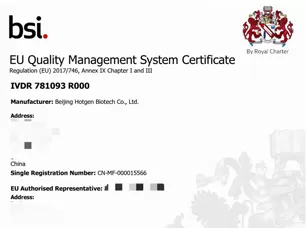Up-converting phosphor technology (UPT) is characterized by submicron-sized particles composed of ceramics doped with rare-earth elements, including the lanthanides, scandium (Sc), yttrium (Y), and others from the group of 17 rare-earth elements, which exhibit exceptional biological and chemical compatibility along with surface functional activity. A defining feature of these particles is their unique optical up-conversion property, enabling the emission of light with a shorter wavelength than the excitation light (converting low-energy light into high-energy light). This property makes UPT an excellent labeling tool in biological applications. Compared to fluorophores or fluorescent particles, UPT offers advantages such as rapid response, resistance to quenching, background-free detection, high sensitivity, and superior stability.
Characteristics of Up-Conversion Luminescent Materials
As novel biomarkers, up-conversion luminescent materials can be integrated with immunochromatographic techniques and optical sensing technologies for biomedical diagnostics, demonstrating the following key features:
High Sensitivity
The unique up-conversion luminescence mechanism eliminates interference from background light, ensuring unparalleled sensitivity during detection.
High Flexibility
The luminescent properties of up-conversion luminescent materials, combined with their diverse and freely tunable characteristic spectra (absorption and emission spectra), make them suitable for multiplex quantitative analysis.
High Stability
UPT luminescence is a purely physical process originating within the material's structure. Its excitation with low-energy infrared light minimizes degradation or quenching caused by sample corrosion or marker instability.
High Safety
Up-conversion luminescent materials are inert synthetic materials that, during their excitation process, pose no harm to the user, the sample being tested, or the environment.
Applications of UPT in Immunoassay Technology
UPT in Clinical Diagnostics
The UPT2800 analyzer by Hotgen integrates rare-earth nanoparticles with immunochromatographic and optoelectronic analysis technologies, providing a robust laboratory platform. This system features minimal sample requirements, rapid detection, ease of use, and stable results. The reagents compatible with the UPT analyzer encompass a wide range of in vitro diagnostic products, including markers for cardiovascular and cerebrovascular diseases, inflammatory markers, renal disease markers, rheumatoid markers, tumor markers, and preterm birth prediction markers.
The easy-to-use UPT device supports various sample types, including serum, plasma, whole blood, animal tissues, and even decayed specimens. Detection is completed within 10–15 minutes, enabling rapid, sensitive, and quantitative testing across different healthcare facilities, from tertiary hospitals to community clinics.
Hotgen UPT2800 Hospital Laboratory Testing Items:
Cardiac: NT-proBNP, cTnI, cTnT*, MYO, CK-MB, D-dimer, H-FABP, Lp-PLA2, cTnI + CK–MB + MYO*, cTnI + NT-proBNP*
Inflammation: CRP, PCT, SAA, IL-6, CRP+SAA*, PCT+IL-6*
Rheumatoid arthritis: Anti-CCP
Bone metabolism: 25(OH)VD (sandwich method)
Fertility: AMH
Renal injury: NGAL
Preterm Birth: fFN
Diabetes: ADP*, INS*, C-P*
Liver disease: AFP, HA, LN, CⅣ, pⅢNP, TIMP-1
Covid-19, ...
UPT in Food Safety Testing
UPT facilitates rapid and quantitative detection of various foodborne pathogens and mycotoxins, including E. coli O157, Vibrio cholerae O1/O139, Staphylococcus aureus, Listeria, Salmonella, aflatoxin, zearalenone, and deoxynivalenol. UPT offers the advantage of high throughput compared to colloidal gold technology, making it highly effective for the rapid detection of contaminating bacteria in food and environmental samples.
Public Safety Testing Applications of Hotgen UPT2800:
DOA: KET, MET, MOP.
Mycotoxins: AFB*, F-2*, DON*, OC*, FMN*, T-2*.
UPT: Methodology Recognized by the National Technological Invention Award of China
Beijing Hotgen Biotech Co., Ltd. has established China's first luminescence detection technology platform with fully independent intellectual property rights. It is the only company in the world to apply rare-earth upconversion luminescent materials in clinical laboratory and biosafety fields. Hotgen holds the core UPT technology and owns more than 20 domestic and international patents. Its level of industrialization and market application is globally leading. In 2015, Hotgen won the China National Technology Invention Award and received the award from the highest national leadership at the Great Hall of the People on January 8, 2016.

Future Prospects
Up-converting Phosphor Technology, as an emerging technology, has a wide range of applications. The discussion above focuses only on its use in medical testing; however, in the medical field, this technology can also be applied to in vivo imaging, tumor therapy, and other areas. From a technical perspective, due to the unique properties of UCP particles, increasing the luminescence efficiency of the particles and enhancing their water solubility remain key challenges in the development of this technology. Another goal for its development is to integrate this technology with existing technologies (such as magnetic particle immunoassay, energy transfer resonance technology, nucleic acid detection technology, liquid-phase detection technology, microfluidic technology, etc.) to create faster and simpler methods. Furthermore, the development of fully automated UPT detection systems and compact handheld field detection devices is a technological driving force to maintain the vitality of this technology.
 English
English français
français Deutsch
Deutsch Español
Español ไทย
ไทย русский
русский português
português العربية
العربية Indonesia
Indonesia








